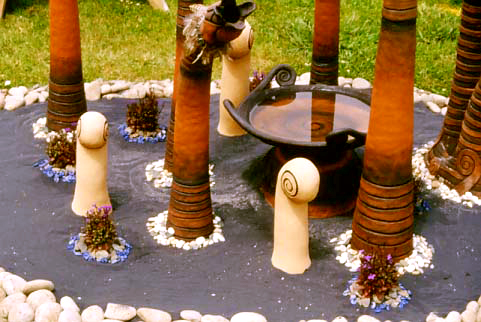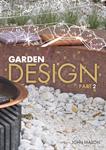Art In The Garden
Art and gardening have been closely linked throughout the centuries. Since the earliest civilisations, sculpture, wall paintings and decorative architectural features have been used outdoors as religious icons, as status symbols to signify wealth and power, and simply as attractive garden ornaments.

Nowadays, garden art encompasses an extremely wide variety of styles, from many different cultures. Outdoor artwork ranges from tromp l’oeil (scenic wall paintings), to sculptures, fountains, wall hangings, decorative planters, and architectural features such as garden arches. They can be formal or informal, traditional or modern, serious or frivolous, expensive and exclusive, or cheap and mass produced. Depending on how they are used, any of these garden artworks can be used to enhance your outdoor space.
PLACEMENT
Whether you’re planning an outdoor gallery or simply have one sculpture that you wish to feature, think carefully about placement. Do you want the artwork to be a major focal point, drawing attention as soon as you step outside, or are you planning to merge it into the garden?
Consider the following points:
- A large object needs to be viewed from a distance to be seen properly.
- Something small becomes lost from a distance.
- Will the style or fashion of the art work fit in with your garden. For example a modern abstract piece may look out of place in a formal, geometrically designed garden.
- Will the colour or colours of the art work merge into, or stand out from the colours of your garden?
- Can the art work be easily damaged?
- Does it need to be placed where it will not be hit by flying balls or other children’s toys?
- Does it need protection from extremes of weather, such as bright sunlight or strong winds?
Some ideas on where to place outdoor art
- At the end of a path – This always works well, drawing visitors through the garden to have a closer look
- Against a neutral backdrop – A courtyard wall is the ideal background for showing off many types of sculpture and artwork
- Amongst overhanging plants to create a sense of mystery – Give the plants an occasional light trim so that they don’t completely crowd out the sculpture
- Surrounded by plants in a garden bed – In most cases, simple low plantings work best because they don’t compete with the sculpture
- Backed by a tall hedge – This gives a similar effect as a courtyard wall, i.e. a bland, uniform surface against which to display sculpture
- Behind, or surrounded by, a pool of water to get a reflection – Make sure the style and scale of the water feature is in keeping with the sculpture and surrounding garden area
- Placed in front of a mirror mounted on a wall – A useful trick for reflecting sculpture (and increasing the amount of light in the garden)
- Placed on a mount (of brick or stone) – Mount can give added stability (if you cement the sculpture on to it) and will raise the sculpture to a more prominent view (don’t overdo it though, the height of the mount should be in keeping with the height of the sculpture)
- Adjacent to outdoor lighting – Allows you to enjoy the artwork at night. Use downlights, uplights and spotlights for different effects
- Strategically placed in an open area – Such as a lawn or paved area, where they can be readily observed, without creating obstacles to clear access
- Hanging (mounted) from a tree – Perhaps peering down at you from a height, or partially hidden behind a tree trunk or behind branches, and appearing to peek out at you
GARDEN SCULPTURE
Sculpture comes in all sizes and styles, from classical to modern, from tiny garden gnomes to life size people sitting atop life size horses.
The Material

- Construction materials include wood, stone, metal, terracotta, marble and concrete
- Moulded concrete statues are often inexpensive because they can be mass produced
- The quality varies (as does the price) so look carefully before you buy
- The really cheap ones can easily be chipped and the features may be crudely reproduced
- Also look at the colour – generally slightly grey (but not too grey) tones are easier to blend in with the garden than harsh white concrete
- Statues made from other materials cannot be mass produced so they are considerably more expensive. However, a considerable advantage is that each piece is unique, and providing it is appealing and well made, is likely to increase in value. Sculpture, like other works of art, can be a profitable investment
- When you’re buying, judge each piece by its own merits – it should be in proportion with the surrounding area, it must suit your house and style of garden, and above all, you must like it, because it’s likely to be around for a long time.
The Style (Where and how to use different styles)
Classical sculpture (Greek, Roman, etc.)
- Commonly available, generally suited to more formal gardens, although they can also look good in natural settings (see for example, Norman Lindsay’s sculptures in this issue)
- The more successful classic sculptures are larger in size than other mass produced sculptures (such as gnomes and animals)
- Don’t overdo this type of sculpture – they need space to be appreciated so if you’re planning to use more than one, place them in different parts of the garden where they won’t compete with each other.
Fantasy sculptures (Gnomes, gargoyles, fairies)
- Mass produced concrete gnomes, fawns and the like have been around for many years and are still popular features of the suburban garden
- Small terracotta fairies and animals are also becoming increasingly popular, especially for younger children
- They’re usually fragile so place them in a sheltered spot.
Eclectic sculpture (welded pieces of junk, old garden tools, old doors, gates, etc)
- These are frivolous, one-off pieces
- Some are available at garden art shops but most are made by garden owners
- If you’re after something truly unique and affordable, this is your best option!
Modern (abstract) sculptures
- Not commonly available, and until recently were either commissioned by private buyers or sold through galleries
- Now modern sculptures and other artworks can be bought at specialised garden art shops and some large garden centres
Want to Know More?
Consider doing a course or buying a reference book from our school.
If you would like to communicate with one of our professional tutors, consider using our free course counselling service. click for details
If you want to browse our bookshop, go to www.acsbookshop.com
VISIT OUR ACS ONLINE E BOOKSTORE
 Quality ebooks written by our staff
Quality ebooks written by our staff- Wide range of Horticulture titles by John Mason, author of over 40 gardening books, garden magazine editor, nurseryman, landscaper and principal of ACS.
- Ebooks can be purchased online and downloaded straight away.
- Read on an ipad, computer, iphone, reader or similar device.
- New titles published every month –bookmark and revisit this site regularly
- Download sample pages for free, to see what each book is like.
- CLICK FOR DETAILS
Titles include:
Commercial Hydroponics 3rd edition
One of the worlds best selling hydroponic books, first published in 1991 by Kangaroo Press. Dozens of colour photos, unique and rarely published advice on how to grow over 100 different types of plants (vegetables, herbs, flowers, indoor plants) in hydroponics.
The Environment of Play 2nd edition
A unique and inspirational view of designing play spaces for children. Full of photos, an inspiration for parents, child care workers, teachers, play leaders, landscape designers and park management professionals. First edition was published in the 1980’s by Leisure Press in New York.
Growing Trees and Shrubs for Small Gardens 2nd edition
First edition published by Kangaroo Press/Simon & Schuster.
Tropical Plants 2nd edition
Trees and Shrubs for Warm Places First edition
A valuable reference for growing plants not only in the tropics and sub tropics, but also greenhouses, inside the home or even hot courtyards in a temperate garden. Never before been published. The book contains colour photos of close to 300 plants and descriptions of many times that number (and largely different to the plants covered in our Tropical Plants book).
Garden Design Part 1 1st edition
A huge book with around 300 inspiring colour photos; that explains how to design a garden in a way that is able to be understood by a beginner, but full of tips and ideas that can help even seasoned professionals.
Garden Design Part 2 1st edition
Following on from Garden Design Part 1, this presents approximately 300 more photos, and a huge amount of inspirational reading to help you (in particular), understand the different styles of garden and the options open to you as a garden designer, or a home owner.
Starting a Nursery or Herb Farm 3rd edition
Another best selling print book, now available as an e book. Previously published by Night Owl (first ed) and Simon and Schuster (2nd ed).
Starting a Garden or Landscape Business 2nd ed.
Previously published by Simon and Schuster; this is a must read for anyone wanting to set out on a career in horticulture.
Discounts offered for students of ACS Distance Education
More from ACS
Ebook - Inspiring: covers formal, natural, eclectic, modern, oriental, Mediterranean; zoom in on stunning images and plans.
View eBook
Ebook - Explores garden design ideas and inspires
garden design and landscaping!
View eBook
Course - Popular design certificate that has launched many enthusiastic and talented design students into the industry.
View Course
Become a Landscape Professional in 2 to 3 years
View Course